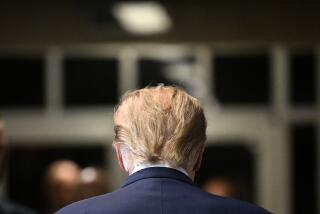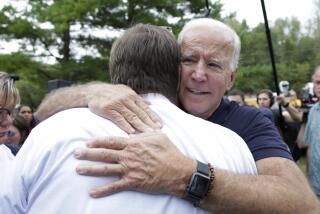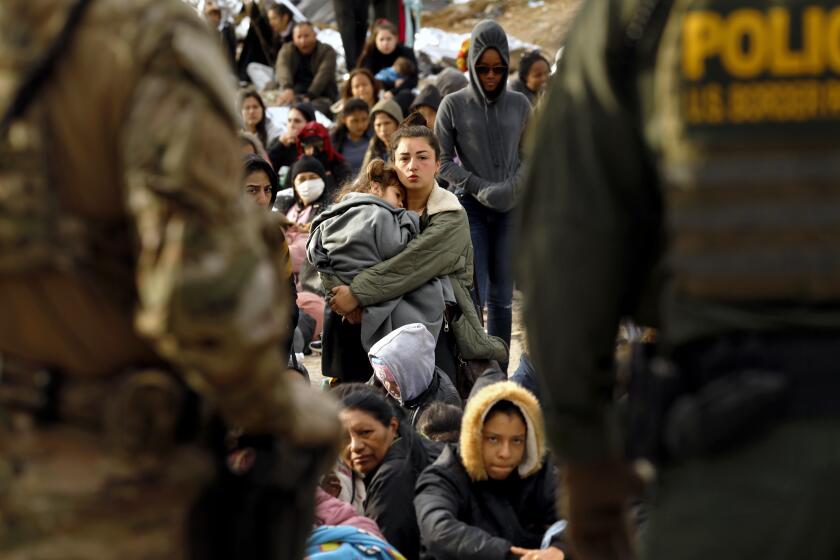Unions labor to rally rank and file for elections
As workers streamed last week from the historic brown brick factory that makes Hershey’s Kisses, they were greeted by hugs from the president of the AFL-CIO, Richard Trumka, who was on a campaign tour urging workers to support Democrats in the coming election.
“Vote for working families,” he implored. “Let’s save American jobs.”
Wearing hair nets and carrying toolboxes, many members of Chocolate Workers Local 464 nodded politely to the union president and took a leaflet. Then they encountered a phalanx of shop stewards and co-workers who called them by name and repeated Trumka’s exhortation.
Sheet metal worker Pete May stepped through the gantlet, clutching a flier headlined “Our Side,” and promised to support the listed Democratic candidates, even while acknowledging many of his co-workers still prefer to just “vote ‘no’ ” this election.
Getting sympathetic rank-and-file union members to vote is a top concern for Democrats in a year that has seen widespread disenchantment with the economy and Democratic leadership in Washington.
Pennsylvania’s Senate, House and local legislative races have emerged as some of the closest in the country, and the final get-out-the vote and “persuasion effort” by Trumka and other union officials may represent the last firewall for Democrats.
Nationwide, unions are spending at least $200 million, closely tracking members’ early voting activity and arranging phone banks, door-to-door contacts and get-to-the-polls transportation efforts. The American Federation of State, County and Municipal Employees has dedicated $87 million this election cycle, making it the largest single outside spending group this election, exceeding the U.S. Chamber of Commerce.
“It’s the most data-driven and sophisticated effort we’ve ever undertaken,” says Karen M. White the political director of the National Education Assn., the teachers union that will spend $40 million on political activities this year.
Union officials say they are seeing results.
For example, internal AFL-CIO tracking polls now show that the Democratic Senate candidate, Rep. Joe Sestak, has dramatically improved his standing with union voters since Labor Day. In early September, Sestak had a slim, 6-point lead among Pennsylvania union members over his GOP rival, former Rep. Patrick Toomey.
By last week, it had climbed to a 29-point margin. At the same time, another poll showed Sestak ahead of Toomey for the first time, even though the margin was very narrow.
Pennsylvania’s union voters make up 12% of the voting age population but constitute up to 32% of those who vote in a typical election year. That’s why major unions here and in other states invest so heavily in the relatively invisible work of reaching out personally to members and sympathetic households.
The Service Employees International Union, for example, is spending $2 million in Pennsylvania this election. Nearly all of it goes to a closely coordinated persuasion and get-out-the-vote effort. The National Education Assn. is spending about $2 million in the state, using micro-targeting techniques segmenting its members — and those who sympathize with the association — by interest, occupation and whether they live in a battleground congressional or state legislative district.
“This is a challenging year for us,” Trumka acknowledged as he waited for the next group of chocolate workers.
The Hershey factory, on a rolling landscape flanked by smokestacks that emit sweet fumes and by the pillars of the nearby Hershey Park rollercoaster, is scheduled to close in coming months, replaced by a modern facility outside town that will employ fewer workers. Union members are more troubled about the economy than in any recent election.
Recently, the AFL-CIO started a new tax-exempt organization, Working America, which reaches out to workers who are not members of unions. The organization’s director, Karen Nussbaum, says her field staff conducts 35,000 conversations a week and hears about the frustration of voters.
“People say they voted for change and don’t see change,” she said. “This is not like 2008 where you have a sense of momentum.”
On the other hand, she said, her field staff reports that undecided voters are opening up, asking questions and are receptive to the messages of Democratic candidates in Ohio, Pennsylvania and other battleground states.
In California, state labor federation spokesman Steve Smith said labor has exceeded its goals in enlisting volunteers for its get-out-the-vote effort. Similar reports come in from Illinois, Nevada, Missouri and other battlegrounds. Karen Ackerman, the AFL-CIO political director, says that, all told, union volunteers have so far given out 17.5 million leaflets, talked to workers at over 4,000 work sites, and knocked on 1.3 million doors.
“This is the best machine labor ever built,” says Amy B. Dean, former AFL-CIO official in Silicon Valley and author of the book “A New New Deal.” But Dean said she was unsure whether it will motivate discontented workers.
“I suspect it will be a less than robust response,” she said. “The gap between the high expectations President Obama created in his last campaign and what he chose to prioritize in office will be felt as a ho-hum response in the field.”
Staff writer Kim Geiger in Washington contributed to this report.
More to Read
Get the L.A. Times Politics newsletter
Deeply reported insights into legislation, politics and policy from Sacramento, Washington and beyond. In your inbox three times per week.
You may occasionally receive promotional content from the Los Angeles Times.






